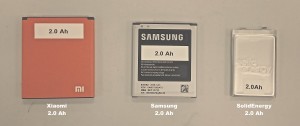 SolidEnergy is taking a fresh approach to battery innovation made possible through its non-traditional business model. By leveraging existing Li-ion manufacturing capabilities and focusing on core battery materials rather than battery manufacturing, SolidEnergy has developed an “anode-less” battery prototype with more than 1200 Wh/L in energy density in a fraction of the time a traditional battery company requires to develop a working prototype.
SolidEnergy is taking a fresh approach to battery innovation made possible through its non-traditional business model. By leveraging existing Li-ion manufacturing capabilities and focusing on core battery materials rather than battery manufacturing, SolidEnergy has developed an “anode-less” battery prototype with more than 1200 Wh/L in energy density in a fraction of the time a traditional battery company requires to develop a working prototype.
Today’s first generation Li-ion batteries use graphite anodes offering an energy density of less than 600 Wh/L, while emerging second generation batteries with silicon-based anodes can reach 800 Wh/L. Though third generation lithium metal batteries can deliver even greater energy density, Li-Air and Li-Sulfur batteries still remain a long way from commercialization. In addition, all-solid-state batteries are unable to operate at room temperature, making them impractical for consumer electronics and electric vehicles.
In contrast, SolidEnergy’s 2 Ah cells have demonstrated more than 1,200 Wh/L in volumetric energy density and high power density at room temperature validated by A123 Systems LLC. SolidEnergy accomplished this with a near “anode-less” design that consists of an ultra-thin metal anode made of thin lithium on copper, which enables ultra-high energy density, and a safe and high efficiency electrolyte, which enables high current density at room temperature.
By supplying anode and electrolyte materials directly to battery manufacturers as a drop-in replacement, SolidEnergy significantly reduces infrastructure cost and commercialization time. In addition, its materials are cathode-agnostic and compatible with a wide range of mobile energy storage applications.
“We estimate that global next-generation advanced battery revenue will grow from $182.3 million in 2014 to $9.4 billion in 2023. While the advanced battery industry is growing at an extremely aggressive pace with Li-ion leading the charge, there are still many problems, including high manufacturing costs and safety issues,” explained Sam Jaffe, principal research analyst, Navigant Research. “The opportunity for next-generation battery companies that can not only offer cheaper price points and safer chemistries, but also demonstrate improved energy density, is enormous.”
SolidEnergy has established partnerships with several large battery manufacturers in Asia as well as some of the world’s largest consumer electronics companies. In fact, SolidEnergy is developing a battery for Project Ara, an effort to create an ecosystem for third party module developers, to change the way innovation happens in the hardware space and make it a lot like the software space and App store model. Since SolidEnergy’s “anode-less” battery is designed specifically for high capacity in a small space, it can provide high capacity within the limited battery space in the Project Ara modular phone, significantly increasing the battery lifetime. As a third party module developer, SolidEnergy will be able to sell battery modules directly to consumers.
While SolidEnergy and A123 share the same MIT roots, SolidEnergy was founded in 2012, one of the toughest years in the American battery industry with several large battery companies, including A123, filing for bankruptcy. This trend pushed SolidEnergy to discover and pursue a new and more efficient business model, focused on core materials R&D and partnering with battery companies on manufacturing. In 2013, SolidEnergy formed a partnership with the newly formed A123 Venture Technologies to leverage its state-of-the-art facilities to accelerate its commercialization. In 2014, just one year after raising funding, SolidEnergy introduced its first generation commercial prototype and broke the world record in energy density – unprecedented in the battery industry.
“Traditionally, innovation and commercialization in the battery space required significant funding and at least three to five years, with results that were not all encouraging,” said Dr. Qichao Hu, founder and CEO of SolidEnergy. “SolidEnergy wants to change that by introducing the innovation speed and business model of the software app industry to the battery industry. Beginning with our partnership with Google and continuing with many others in the pipeline, we hope to be the phoenix that will rise from the ashes of traditional battery companies that have come before us.”







